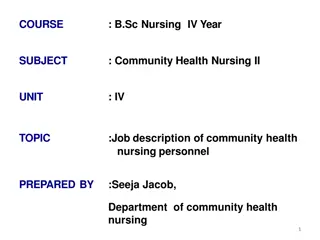Community Health Bag: Definition, Purpose, and Techniques for Nursing Interventions
Community health bag is a vital tool for nurses during home visits, containing materials for nursing interventions. The bag technique involves skill in preparing and using these tools effectively. Its purpose includes providing medical care, first aid, maternal care, and health education. Principles of cleanliness, sterilization, and restocking guide its use, along with techniques for selecting work areas and organizing the bag.
Download Presentation

Please find below an Image/Link to download the presentation.
The content on the website is provided AS IS for your information and personal use only. It may not be sold, licensed, or shared on other websites without obtaining consent from the author.If you encounter any issues during the download, it is possible that the publisher has removed the file from their server.
You are allowed to download the files provided on this website for personal or commercial use, subject to the condition that they are used lawfully. All files are the property of their respective owners.
The content on the website is provided AS IS for your information and personal use only. It may not be sold, licensed, or shared on other websites without obtaining consent from the author.
E N D
Presentation Transcript
Definition Community health bag is the vehicle for carrying the tools needed during a home visit TNAI Community health bag is the carrier containing the tools , equipments and materials needed during the nurse s visit to home for performing nursing interventions which include various diagnostic tests, demonstration of care and patient care activities
-Community health bag made up of leather, canvas, or light metals -the material should be dark in colour washable and durable -Community health bag should be stable and should not be collapsed when placed over a surface
BAG TECHNIQUE Definition Bag technique refers to the skill and knowledge in preparing and using the materials and equipment in the community health bag for performing various nursing interventions at home
Purpose -to assess the need of the individual and family -to provide emergency first aid services in case of minor ailments and accidents -to provide primary medical care in case of acute and communicable diseases -to provide antenatal, postnatal and intranatal care to mothers
-to provide essential care to infants and children -to provide follow up services in case of chronic illness -to demonstrate nursing procedures -to provide appropriate health educations
WHEN AND WHERE TO USE THE COMMUNITY HEALTH BAG -for any nursing procedures carried out at home -for demonstrations -follow up advices and health education to the families
Principles of bag technique -principle of cleanliness -principle of sterilization -principle of protection after care -principle of improvisation -principle of restocking -principle of economy of material and time
Techniques of using community bag 1.Select a work area where you can keep the bag without the danger of contamination 2. Spread the newspaper 3. Preliminary assessment by interaction with the family and observation of the existing situation to decide the plan of care 4. Unbuckle the top flap and remove the hand washing articles from the outer pocket 5. Hand washing
6. Open the inner cleanest compartment and remove all the needed equipment from it 7. Arrange the articles on the spreadsheet 8. Close the inner pocket 9. Carry out nursing procedures 10. Give health education during the procedure 11. On completion discard the waste material properly
12. Articles from the cleanest compartment should be washed and wash all the articles 13. Dry the articles and replace the articles in the inner pocket first 14. Do hand washing and replace the hand washing articles 15. Close the bag
16. Record the procedures 17. Inform the family about the next visit 18. Carry the bag on the shoulder and replace the spread sheet on the inner pocket
Care of bag -keep away from heat, moist, dust and rain -it should be replenished with drugs , dressing and other supplies according to their consumption -should be cleaned once in a week (it include removing all the articles in the bag on to a clean towel spread over a table, washing and drying the bag, labeling the bottles if needed)
- Bag should be strictly cleansed and its contents should be disinfected after attending the patients with infectious diseases
Common nursing procedures at home -hand washing -urine analysis -vital signs -wound dressing -under five assessment
-physical examination -medicine administration -antenatal examinations -eye care and vision testing -steam inhalation -health education
Compartments of bag -Bag has got different compartment according to the type of articles kept -usually 2 types-- inner and outer -all pockets of the bag should be kept on a clean surface
Outer pockets -Two outer pockets -at the opposite side of the face of the bag - One outer pocket carries the spread sheet (for keeping the bag and articles in use) , health education materials, paper bag, apron, fetoscope , stethoscope, vision testing charts, growth chart, recording items, pencil, pen, scale, measuring tape etc
-second outer pocket carries hand washing articles ( soap with soap dish, towel, scrub brush ) in a polythene cover, rag pieces, specimen bottle etc.
Inner pockets -cleanest compartment contain articles and supplies for procedure which are to be carried out at strict asepsis {2artery forceps, thumb forceps, scissors, metal box (gauze, cotton swabs, dressing pad) 2 steel bowl, Blade, Syringe and needle-2each, Microscopicslide-1box, 1Roller bandage, Adhesive tape-1roll, Mask-2,Gloves-2}
- one cleaner compartment contain articles and supplies for procedure which are to be carried out with general principles of cleanliness {urine sugar articles(Test tube-2, Test tube holder-1,Test tube cleaning brush-1,Dropper-1 Lighter-1,Spirit lamp-1,match box,kidney tray) articles for checking vital signs , one cover contain Tab. Paracetamol (500mg),Tab.Bcomplex (20-25mg),Folic acid tablet (30- 60mg),Tab.mebandazole(100mg),ORS packet- 2- 5 packets,Tab.CPM, Torch-1}
-2ndinner compartment has got various pockets which carries all solutions (Spirt-50ml,Betadine solution- 50ml,dettol solution-50ml, 5%acetic acid-50ml ,Liquid parafine-50 ml, benedict solution)























